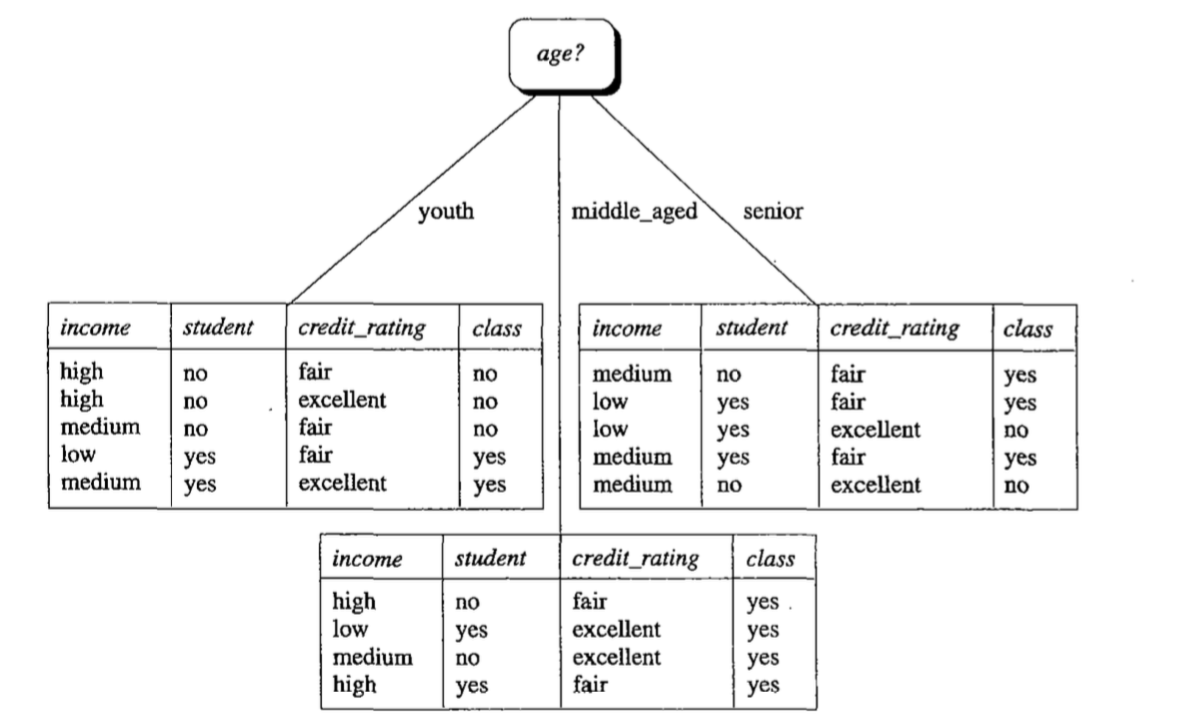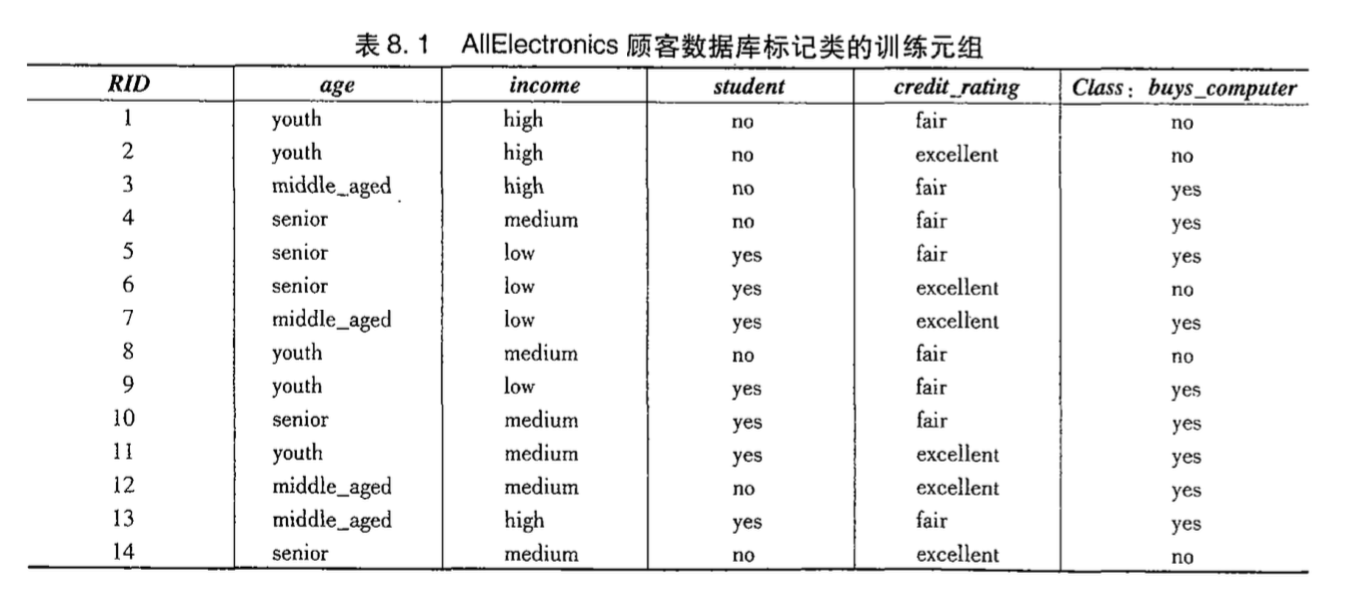@xtccc
2016-04-28T01:13:01.000000Z
字数 14294
阅读 4453
Decision Tree

数据挖掘&机器学习
目录
信息论基础
对于包含以下4个符号的系统,A, B, C, D,我们可以有多种方法对其进行编码。例如:
方法1:
| 符号 | 编码 | 出现概率 |
|---|---|---|
| A | 00 | 0.1 |
| B | 01 | 0.2 |
| C | 10 | 0.2 |
| D | 11 | 0.5 |
方法2:
| 符号 | 编码 | 出现概率 |
|---|---|---|
| A | 0 | 0.2 |
| B | 10 | 0.2 |
| C | 110 | 0.3 |
| D | 111 | 0.3 |
在方法1中,平均每个符号的编码占用2个bits;在方法2中,平均每个符号的编码占用2.4个编码。其他的编码方式也许需要更多或更少的信息量来进行编码。
Entropy(熵)
那么,平均对每个符号进行编码的信息量的最小值是多少呢?这与每个字符在系统中的概率分布有关。
假设系统中有N个符号,符号出现的概率为,那么对该系统中每个符号进行编码平均所需的信息量(bits的数量)为:
这里的H(X)就是变量X的熵(entropy)。
Conditional Entropy(条件熵)
假设数据集有2个attribute,分别是X和Y,例如:
| X | Y |
|---|---|
| Math | Yes |
| History | No |
| CS | Yes |
| Math | No |
| Math | No |
| CS | Yes |
| History | No |
| Math | Yes |
那么,可以算出,
H(X) = 1.5, H(Y)=1。
H(Y|X=Math) = 1,H(Y|X=History) = 0,H(Y|X=CS) = 0。
可见,随机变量分布得越均匀,它的熵就越小。
条件熵H(Y|X)的算法为:
Infogamtion Gain
信息增益的值总是非负的。
决策树算法
基本
决策树算法是一个贪心算法Greedy Algorithm,常常用于分类与回归。Tree ensemble algorithms(例如 random forests 和 boosting)常常是用于解决分类与回归问题的最好算法。
重点
决策树算法是一个supervised learning,因为训练集会提供每一个tuple的class tag。
决策树很容易理解,不多赘述了。其中,最关键的步骤是怎样选择一个最重要的attribute,并根据它的值来对数据集进行切分。
所谓最重要的attribute,是指用该attribute来切分数据集时,能够使得由数据集切分出的子集尽可能的纯净。
例如,如果按照某个attribute能将数据集切分成n个子集,且每个子集中的tuples都属于各自的class,那么,这个attribue就可以认为是最重要的attribute。因为这些切分出的子集,都是纯净的(**pure**)子集。
或者可以这样表述:最重要的attribute,是指用该attribute来切分数据集的前后,information gain最大
那么,怎样来选择最重要的attribute呢?有三种方法:
1. Information Gain (ID3算法使用)
2. Gain Ration (C4.5算法使用)
3. Gini Index (CART算法使用)
Attribute Selection Measures
构造决策树时,在每一个节点处,需要决定该节点选择哪一个attribute来对相应的数据集进行划分。理论上最好的attribute,将使得划分出的每一个子集中的数据都属于同一个class(这样的子集被称为pure partition)。当然实际上不大可能每一个节点都做到如此。
将训练数据集记为,含有个class,其中第个class的子集记为。
数据集的Entropy
Entropy被用于描述一个集合中的内容的不纯净程度(impurity),它在数学上的定义为:
这里,D为全集,共包含m个不同的class,为D中第i个class所占的比例,即
D的entropy越高,它所包含的信息量越大。
如果D中的数据全部属于同一个class,那么D的entropy为0,显然这对于数据挖掘没什么用;如果D中有50%数据属于class A,50%数据属于class B,那么D的entropy为1,对于数据挖掘而言这是一个非常好的数据集。
在构造决策树时,我们希望知道:决定D中数据点属于哪一个class时,哪一个attribute是最重要的? 而Information Gain就可以告诉我们哪一个attribute是最重要的。
Information Gain (信息增益)
关于Information Gain的概念, 这篇文档 讲的不错。
ID3算法采用了信息增益来选择最重要的attribute。
对于决策树中的dataset而言,它的信息增益为:
这里的entropyAfterSplit是决策树中某节点的所有branch中数据的entropy的带权之和,一个branch的权重就是该branch中的tuples数量与该节点中tuples数量之比。
如果将数据集按照attribute A进行划分,同时A在数据集中有v个值,并且按照A的属性值可以将D划分为对应的v个partition,即 , , ..., ,其中中数据点的属性A的值为。那么,数据集D在属性A处的entropy为:
数据集D在属性A处的信息增益为:
对数据集的每一个attribute都计算其信息增益,选择信息增益最大的attribute来切分数据集。
举个例子:
Building the Decision Tree
构造决策树的过程是一个递归的过程。
- 首先,选择数据集内信息增益最大的attribute作为根节点;
- 为根节点的attribute的每种value分别创建一个branch,将对应的tuple归入该branch内。对每个branch内的数据子集,继续构造决策树。
- 重复以上步骤, 直到某一个branche满足以下任意条件时停止:
a). 所有的attribue都被用过了,如果此时该branch内的tuples不属于同一个class,则采用多数人投票的方法,为该branch添加一个leaf node,并为其标记一个class tag;
b). 该branch内的所有数据点都属于同一个class,此时为该节点创建一个leaf node,并将其标记一个class tag;
Python代码实现
下面用Python代码来实现决策树的构造过程。为了简单起见,这里只支持nominal类型的数据。
假如我们有以下数据,来判断一个tuple是不是一条鱼:
| Can survive without coming to surface? |
Hash flippers? | Is it a fish? |
|---|---|---|
| 1 | 1 | yes |
| 1 | 1 | yes |
| 1 | 0 | no |
| 0 | 1 | no |
| 0 | 1 | no |
这里,前两列是数据集的两种feature,最后一列是对应的class。
在下面的代码中,我们将假设数据集都是这种形式的。
创建数据集
def createDataset():dataset = [[1, 1, 'yes'],[1, 1, 'yes'],[1, 0, 'no'],[0, 1, 'no'],[0, 1, 'no']]labels = ["Can Survive", "Has Flipper"]return dataset, labels
计算entropy
首先回忆一下怎样计算一个数据集D的entropy。
Entropy被用于描述一个集合中的内容的不纯净程度(impurity),它在数学上的定义为:
这里,D为全集,共包含m个不同的class,为D中第i个class所占的比例,即
下面是实现代码。
def calcShannonEntropy(dataset):classCount = {} # 每一种class的数量datasetSize = len(dataset)# 计算每一种class的在数据集中出现的次数for t in dataset:classTag = t[-1]if classTag not in classCount.keys():classCount[classTag] = 0classCount[classTag] += 1# 计算entropyentropy = 0.0for classTag in classCount.keys():prob = classCount[classTag]/float(datasetSize)entropy -= prob*log(prob, 2)return entropy
按照feature对数据集进行划分
############################################################# 对数据集按照某个feature进行切分# 其中,dataset的每个元素是一个一维数组(长度为N),前N-1个元素每个# 都是1个feature,最后一个元素是该数据的class tag。# 本方法要按照第`splitIndex`个feature对数据集进行切分,# 返回该feature的值等于`value`的所有记录# splitIndex的范围在[0, N-1]之间:# 返回的子集中,已经删除了splitIndex对应的feature,即返回的子集# 中的每条记录含有N-2个feature############################################################def splitDataset(dataset, splitIndex, value):subset = []for t in dataset:if t[splitIndex] == value:reducedVec = t[:splitIndex]reducedVec.extend(t[splitIndex+1:])subset.append(reducedVec)return subset
请注意Python中List的两个方法(extend和append)的区别。
计算最重要的feature
回顾一下什么才算是最重要的feature。
如果将数据集按照attribute A进行划分,同时A在数据集中有v个不同的值,并且按照A的属性值可以将D划分为对应的v个partition,即 , , ..., ,其中中数据点的属性A的值为。那么,数据集D在属性A处的entropy为:
数据集D在属性A处的信息增益为:
对数据集的每一个attribute都计算其信息增益,信息增益最大的attribute就是最重要的feature(最能帮助划分数据)。
代码实现如下。
############################################################# 对于包含N-1个feature的数据集,从中找出信息增益最大的feature,来# 作为该数据集的splitting criteria# 返回的是最重要的feature在数据集的每条tuple中的索引############################################################def chooseBestSplitCriteria(dataset):datasetSize = len(dataset)baseEntropy = calcShannonEntropy(dataset) # 数据集D的熵featNum = len(dataset[0])-1 # feature的数量(维度)bestCriteria = -1 # 最佳split属性的indexmaxInfoGain = 0.0 # 这里有个前提:info gain总是不小于0的!!for i in range(featNum): # 针对每一维的feature来计算featureValues = [t[i] for t in dataset]distinctFeatValues = set(featureValues)subEntropy = 0.0 # D在每一个属性处的entropyfor v in distinctFeatValues: # 针对该feature的每一种值来计算subset = splitDataset(dataset, i, v)prob = len(subset)/float(datasetSize)subEntropy += prob * calcShannonEntropy(subset)# 调试用:print "attribute index -> ", i, "\t subEntropy -> ", subEntropy,"\t info gain -> ", baseEntropy - subEntropyif baseEntropy - subEntropy > maxInfoGain: # 寻找最大的信息增益maxInfoGain = baseEntropy - subEntropybestCriteria = ireturn bestCriteria
构建Decision Tree
这里,我们用Josn的格式来表征一棵树,即:
{ root : {child1: { ... },child2: { ... },...childN : { ... }}}
回顾构造决策树的过程。
构造决策树的过程是一个递归的过程。
- 首先,选择数据集内信息增益最大的attribute作为根节点;
- 为根节点的attribute的每种value分别创建一个branch,将对应的tuple归入该branch内。对每个branch内的数据子集,继续构造决策树。
- 重复以上步骤, 直到某一个branche满足以下任意条件时停止:
a). 所有的attribue都被用过了,如果此时该branch内的tuples不属于同一个class,则采用多数人投票的方法,为该branch添加一个leaf node,并为其标记一个class tag;
b). 该branch内的所有数据点都属于同一个class,此时为该节点创建一个leaf node,并将其标记一个class tag;
实现代码如下:
############################################################# 为一个数据集(nominal类型)构建一颗decision tree# attrLabels是所有attribues label的列表,其中的label的顺序# 与dataeset中每个tuple中的attribute value的顺序必须是一致的############################################################def createDecisionTree(dataset, featLabels):classValueList = [t[-1] for t in dataset] # 取出全部的class values# 如果dataset中全部的数据都属于同一个class,则返回该classif classValueList.count(classValueList[0]) == len(classValueList):return classValueList[0]# 如果dataset中已经没有attribute了,则返回所有class中的majorityif (len(dataset[0]) == 1):return majorClass(classValueList)# 找出目前dataset中最重要的feature的indexbestFeatIdx = chooseBestSplitCriteria(dataset)bestFeatLabel = featLabels[bestFeatIdx]subFeatLabels = featLabels[:]del(subFeatLabels[bestFeatIdx]) # 去掉已经用过的feature labeltree = { bestFeatLabel:{ } } # 构造根节点# 下面处理根节点的每一个branchfeatValueSet = set([t[bestFeatIdx] for t in dataset])for featValue in featValueSet:tree[bestFeatLabel][featValue] = createDecisionTree(splitDataset(dataset, bestFeatIdx, featValue),subFeatLabels)return tree############################################################# 找出最主流的class(按照频率计算)############################################################def majorClass(classList):classCountMap = {}for clz in classList:if clz not in classCountMap.keys():classCountMap[clz] = 1else:classCountMap[clz] += 1# 按照value进行排序,并返回频次最高的class的tagreturn sorted(classCountMap.iteritems(), key=operator.itemgetter(1), reverse=True)[0][3]
测试数据验证
例1
我们要本文上面提到的数据集来验证。
数据集如下:
Can survive without
coming to surface?Hash flippers? Is it a fish? 1 1 yes 1 1 yes 1 0 no 0 1 no 0 1 no
创建数据集的代码为
def createDataset():dataset = [[1, 1, 'yes'],[1, 1, 'yes'],[1, 0, 'no'],[0, 1, 'no'],[0, 1, 'no']]labels = ["Can Survive", "Has Flipper"]return dataset, labels
调用createDecisionTree方法
dataset, labels = createDataset()print json.dumps(createDecisionTree(dataset, labels), indent=4)
输出结果如下:
{"Survive": {"0": "no","1": {"Fish": {"0": "no","1": "yes"}}}}
例2
我们再用《Data Mining: Concepts and Techniques》中的例子来测试。
数据集如下:
创建数据集:
############################################################# 再用一组新数据来测试# 数据来源:《Data Mining: Concepts and Techniques》############################################################def generateDataSet():dataset = [['youth', 'high', 'no', 'fair', 'no'],['youth', 'high', 'no', 'excellent', 'no'],['middle_aged', 'high', 'no', 'fair', 'yes'],['senior', 'medium', 'no', 'fair', 'yes'],['senior', 'low', 'yes', 'fair', 'yes'],['senior', 'low', 'yes', 'excellent', 'no'],['middle_aged', 'low', 'yes', 'excellent', 'yes'],['youth', 'medium', 'no', 'fair', 'no'],['youth', 'low', 'yes', 'fair', 'yes'],['senior', 'medium', 'yes', 'fair', 'yes'],['youth', 'medium', 'yes', 'excellent', 'yes'],['middle_aged', 'medium', 'no', 'excellent', 'yes'],['middle_aged', 'high', 'yes', 'fair', 'yes'],['senior', 'medium', 'no', 'excellent', 'no']]labels = ['age', 'income', 'student', 'credit_rating', 'buys_computer']return dataset, labels
调用createDecisionTree方法
dataset, labels = generateDataSet()print json.dumps(createDecisionTree(dataset, labels), indent=4)
输出结果为:
{"age": {"youth": {"student": {"yes": "yes","no": "no"}},"senior": {"credit_rating": {"fair": "yes","excellent": "no"}},"middle_aged": "yes"}}
这与书上构造出的决策树是一样的。

使用决策树来预测分类
上面已经构建出了决策树,下面将用构建出的决策树预测输入数据的分类情况。
#################################################################### tree : 构建出的决策树# featLabels : feature的名字的列表,例如 ["Survive", "Fish"]# testVec:一条测试数据,但是不知道其class###################################################################def classify(tree, featLabels, testVec):firstStr = tree.keys()[0]innerDict = tree[firstStr]featIndex = featLabels.index(firstStr)for key in innerDict.keys() :if key == testVec[featIndex]:if type(innerDict[key]).__name__ == 'dict':return classify(innerDict[key], featLabels, testVec)else:return innerDict[key]# 测试新的数据的预测分类dataset, labels = createDataset()decisionTree = createDecisionTree(dataset, labels)# print decisionTreeprint classify(decisionTree, ["Survive", "Fish"], [1, 0])dataset, labels = trees.generateDataSet()decisionTree = trees.createDecisionTree(dataset, labels)print classify(decisionTree, ['age', 'income', 'student', 'credit_rating'], ['senior', 'medium', 'no', 'excellent'])
使用MLLib中的决策树工具
Spark版本:CDH5.4.7 - Spark 1.3
我们对上面例1和例2中的数据,应用MLLib来构建决策树。
package cn.gridx.spark.examples.MLlib.algoimport org.apache.log4j.{Level, Logger}import org.apache.spark.{SparkConf, SparkContext}import org.apache.spark.mllib.linalg.Vectorsimport org.apache.spark.mllib.regression.LabeledPointimport org.apache.spark.mllib.tree.DecisionTreeimport org.apache.spark.mllib.tree.model.DecisionTreeModel/*** Created by tao on 11/30/15.** 对MLlib中的决策树工具的使用例子(Spark 1.3)** 参考: http://web.cs.ucla.edu/~linmanna/cs239/* https://spark.apache.org/docs/1.3.0/mllib-decision-tree.html* https://databricks.com/blog/2014/09/29/scalable-decision-trees-in-mllib.html**/object DecisionTreesExample {def main(args: Array[String]): Unit = {Logger.getRootLogger.setLevel(Level.ERROR)val sc = new SparkContext(new SparkConf())Test_SmallCategoricalDataset_1(sc)println("\n\n\n")Test_SmallCategoricalDataset_2(sc)sc.stop}/** 用一个小数据集来测试决策树* 数据集中的tuple的全部feature都是categorical* dataset = [[1, 1, 'yes'],[1, 1, 'yes'],[1, 0, 'no'],[0, 1, 'no'],[0, 1, 'no']]'yes'记为1, 'no'记为1*/def Test_SmallCategoricalDataset_1(sc: SparkContext): Unit = {val trainingData = sc.parallelize(Array(LabeledPoint(1, Vectors.dense(1, 1)),LabeledPoint(1, Vectors.dense(1, 1)),LabeledPoint(0, Vectors.dense(1, 0)),LabeledPoint(0, Vectors.dense(0, 1)),LabeledPoint(0, Vectors.dense(0, 1))))val numClasses = 2// categorical feature info,为空则认为所有的feature都是连续性变量val categoricalFeatureInfo = Map(0 -> 2, 1 -> 2)val impurity = "entropy" // 或者是ginival maxDepth = 5val maxBins = 32val model: DecisionTreeModel =DecisionTree.trainClassifier(trainingData, numClasses,categoricalFeatureInfo, impurity, maxDepth, maxBins)// 将训练出的模型持久化到HDFS文件中,然后再将其读出来使用def modelPath = "/user/tao/mllib/model/tree.model"model.save(sc, modelPath)val sameModel = DecisionTreeModel.load(sc, modelPath)/*** 输出* DecisionTreeModel classifier of depth 2 with 5 nodesIf (feature 0 in {0.0})Predict: 0.0Else (feature 0 not in {0.0})If (feature 1 in {0.0})Predict: 0.0Else (feature 1 not in {0.0})Predict: 1.0这与例1中的结果是一样的!*/println("="*30 + " full model in the form of a string " + "="*30)println(sameModel.toDebugString)println("="*30 + " testing prediction " + "="*30)println("(1, 1) -> " + sameModel.predict(Vectors.dense(1,1)))println("(0, 1) -> " + sameModel.predict(Vectors.dense(0,1)))}/*** 另一个数据集,来自 Data Mining: Concepts and Techniques, 3rd edition是上面例2中的数据集* @param sc*/def Test_SmallCategoricalDataset_2(sc: SparkContext): Unit = {val originalDataset = Array(("youth", "high", "no", "fair", "no"),("youth", "high", "no", "excellent", "no"),("middle_aged", "high", "no", "fair", "yes"),("senior", "medium", "no", "fair", "yes"),("senior", "low", "yes", "fair", "yes"),("senior", "low", "yes", "excellent", "no"),("middle_aged", "low", "yes", "excellent", "yes"),("youth", "medium", "no", "fair", "no"),("youth", "low", "yes", "fair", "yes"),("senior", "medium", "yes", "fair", "yes"),("youth", "medium", "yes", "excellent", "yes"),("middle_aged", "medium", "no", "excellent", "yes"),("middle_aged", "high", "yes", "fair", "yes"),("senior", "medium", "no", "excellent", "no"))// 对数据集进行转换val dataSet: Array[LabeledPoint]= originalDataset.map(t => LabeledPoint(t._5 match { // class tagcase "no" => 0case "yes" => 1},Vectors.dense( // featurest._1 match {case "youth" => 0case "middle_aged" => 1case "senior" => 2},t._2 match {case "high" => 0case "medium" => 1case "low" => 2},t._3 match {case "no" => 0case "yes" => 1},t._4 match {case "excellent" => 0case "fair" => 1})))println("="*30 + " dataset " + "="*30)dataSet.foreach(println)val trainingData = sc.parallelize(dataSet)val numClasses = 2val categoricalFeatureInfo: Map[Int, Int] = Map(0 -> 3, 1 -> 3, 2 -> 2, 3 -> 2)val impurity = "entropy"val maxDepth = 20val maxBin = 32val model =DecisionTree.trainClassifier(trainingData, numClasses,categoricalFeatureInfo, impurity, maxDepth, maxBin)/*** DecisionTreeModel classifier of depth 4 with 13 nodesIf (feature 2 in {0.0})If (feature 0 in {0.0})Predict: 0.0Else (feature 0 not in {0.0})If (feature 0 in {2.0})If (feature 3 in {0.0})Predict: 0.0Else (feature 3 not in {0.0})Predict: 1.0Else (feature 0 not in {2.0})Predict: 1.0Else (feature 2 not in {0.0})If (feature 0 in {0.0,1.0})Predict: 1.0Else (feature 0 not in {0.0,1.0})If (feature 3 in {0.0})Predict: 0.0Else (feature 3 not in {0.0})Predict: 1.0但是,这与书上的例子计算出的Model的结构不同!!!*/println("="*30 + " full model in the form of a string " + "="*30)println(model.toDebugString)println("="*30 + " testing prediction " + "="*30)println("(2, 1, 0, 0) -> " + model.predict(Vectors.dense(2, 1, 0, 0)))}}


